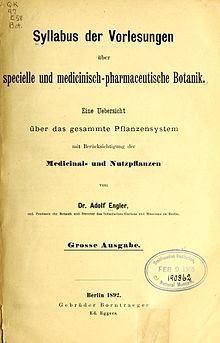Syllabus der Pflanzenfamilien (1892–) by Adolf Engler (1844–1930) is a complete revision of plant families down to generic level and often even further. As such it forms part of the Engler system of plant taxonomy.
Engler's starting point was that of Eichler who had been the first to use phylogenetic principles, and reflected the new post-Darwinian perspective, although Engler himself did not think that his was. His modified Eichler schema first appeared in 1886 in his Guide to Breslau Botanic Garden (of which he was the director) and was expanded in his Syllabus in 1892. This reflected the new post-Darwinian perspective. Engler's Syllabus der Pflanzenfamilien first appeared in 1892 with the title Syllabus der Vorlesungen über specielle und medicinisch-pharmaceutische Botanik. Many subsequent editions have appeared since, and it was continued after Engler's death in 1930. The most recent edition was the 13th in 2009. A number of references to the Engler system actually refer to later revisions ('modified Engler system') undertaken by Melchior and colleagues, the 12th edition of the Syllabus, also referred to as the Melchior system.
Review of previous systems p. xvii Schema p. xx
MyxothallophytaMyxomycetesEuthallophytaSchizophytaDinoflagellataBacillarialesGamophyceaeFungiEmbryophyta Zoidiogama (Archegoniatae)BryophytaPteridophytaEmbryophyta Siphonogama (Phanerogamae)GymnospermaeAngiospermaeChalazogamaeAcrogamaeMonocotyledoneaeDicotyledoneaeThe main groups of plants are shown here with page numbers in (parentheses) and some corresponding volumes in Die Natürlichen Pflanzenfamilien in [square brackets], however there are changes between editions:
Review of previous systems p. xxi
From schema and index (pp. xxiv-xxv)
I. Abteilung. Phytosarcodina, Myxothallophyta, Myxomycetes (p. 1)II. Abteilung. Schizophyta (p. 3) [vol 1 part Ia]III. Abteilung. Flagellatae (p. 6) [vol 1 part Ia]IV. Abteilung. Dinoflagellatae (p. 8) ? Abteilung. Silicoflagellatae (p. 8)V. Abteilung. Zygophyceae (p. 8)VI. Abteilung. Chlorophyceae (p. 11) [vol 1 part II]VII. Abteilung. Charales (p. 15)VIII. Abteilung. Phaeophyceae (p. 15)IX. Abteilung. Dictyotales (p. 18)X. Abteilung. Rhodophyceae (p. 18)XI. Abteilung. Eumycetes (Fungi) (p. 25) [vol 1 part I]XII. Abteilung. Embryophyta asiphonogama (Archegoniatae) (p. 50)I. Unterabteilung Bryophyta (Muscinei) (p. 51) [vol 1 part III: 1]II. Unterabteilung Pteridophyta (p. 61) [vol 1 part IV]XIII. Abteilung. Embryophyta siphonogama (Phanerogamae) (p. 70)I. Unterabteilung Gymnospermae (p. 70) [vol 2 part I]II. Unterabteilung Angiospermae (p. 75) [vol 2 part I]I. Unterabteilung Gymnospermae 6 classes (p. 70) [vol 2 part I]II. Unterabteilung Angiospermae 2 classes (p. 75) [vol 2 part I]1. Klasse Monocotyledoneae 11 orders (p. 76)2. Klasse Dicotyledoneae 2 sublasses (p. 106)Gymnospermae
6 classes (p. 70)
Angiospermae
2 classes (p. 75)
1. Klasse Monocotyledoneae 11 orders (p. 76) [vol 2 part I]2. Klasse Dicotyledoneae 2 sublasses (p. 106)Monocotyledoneae
11 orders
1. Reihe Pandanales (p. 77)2. Reihe Helobiae (p. 77)3. Reihe Triuridales (p. 80)4. Reihe Glumiflorae (p. 80)5. Reihe Principes (p. 84)6. Reihe Synanthae (p. 87)7. Reihe Spathiflorae (p. 87)8. Reihe Farinosae (p. 91)9. Reihe Liliiflorae (p. 93) [vol 2 part I]10. Reihe Scitamineae (p. 101)11. Reihe Microspermae (p. 102)Dicotyledoneae
2 subclasses (p. 106)
1. Unterklasse Archechlamydeae2. Unterklasse Metachlamydeae (Sympetalae) (p. 175)Index (p. 215)
Monocotyledon family structure
11 orders (Reihe)
PandanaceaeSparganiaceaeTyphaceaeHelobiae
4 suborders
subordo Alismatineaesubordo Hydrocharitineaesubordo Scheuchzeriineaesubordo PotamogetonineaeTriuridales
TriuridaceaeGlumiflorae
GramineaeCyperaceaePrincipes
Palmae or ArecaceaeSynanthae
CyclanthaceaeSpathiflorae
AraceaeLemnaceaeFarinosae
6 suborders
FlagellariaceaeEnantioblastaeBromellinewaeCommelinineaePontederiineaePhilydrineaeLiliiflorae
6 suborders (Unterreihe)
- Juncineae (p. 94)
- Liliineae 11 families (p. 94)
- Iridineae families (p. 100)
- Pontederiineae
- Burmanniineae
- Philydrineae
suborder Juncineae (p. 94)subordo Liliineae 11 families (p. 94)subordo Iridineae 2 families (p. 100)subordo Pontederiineaesubordo Burmanniineae 2 familiessubordo PhilydrineaeMusaceaeZingiberaceaeCannaceaeMarantaceaeLowiaceaeOrchidaceaeIn modern classifications, Engler's divisions I - XI are not considered plants but are classified in other groups (although some botanists do accept Engler's divisions VII and VIII, the "green algae", as plants).
Cyanoprokaryota [Part 1/1]Acrasia (Acrasiomycota) [Part 1/1]Eumycetozoa [Part 1/1]ProtosteliaDictyosteliaMyxogastria (Myxomycetes)Phytomyxea (Plasmodiophoromycota) [Part 1/1]Fungi / MycobiontaChytridiomycota [Part 1/1]BlastocladiomycetesChytridiomycetesMonoblepharidomycetesNeocallimastigomycetesZygomycota [Part 1/1]EntomophthoromycotinaMortierellomycotinaMucoromycotinaKickxellomycotinaZoopagomycotinaGlomeromycota [Part 1/1]GlomeromycetesAscomycota [Part 1/2, to be published]Basidiomycota [Part 1/3, to be published]HeterokontobiontaLabyrinthulomycota [Part 1/1]LabyrinthulomycetesOomycota [Part 1/1]HyphochytridiomycetesPeronosporomycetesCryptophyta [Part 2/1]CryptophyceaeGoniomonadeaDinophyta/Dinozoa (Dinoflagellata) [Part 2/1]PerkinseaOxyrrhidophyceaeEllobiophyceaeSyndiniophyceaeNoctiluciphyceaeDinophyceaeHaptophyta [Part 2/1]PavlovophyceaeCoccolithophyceaeHeterokontophyta / Ochrophyta [Part 2/1]Diatomeae, Bacillariophyceae s.l.CoscinodiscophyceaeMediophyceaeFragilariophyceaeBacillariophyceaeOther heterokontophytesBolidophyceaeDictyochophyceaePelagophyceaePinguiophyceaeEustigmatophyceaePicophageaSynchromophyceaeChrysophyceaeRaphidophyceaeChrysomerophyceaeAurearenophyceaePhaeothamniophyceaeXanthophyceaeSchizocladiophyceaePhaeophyceaeGlaucobionta [Part 2/1]GlaucophytaRhodobionta [Part 2/2, to be published]RhodophytaOrganisation type "Green Algae"Chlorarachniophyta / Cercozoa [Part 2/1]ChlorarachniophyceaeEuglenophyta/Euglenozoa [Part 2/1]EuglenophyceaeChlorobionta ("Viridiplantae")Chlorophyta [Part 2/1]NephroselmidophyceaeMamiellophyceaePrasinophyceaePedinophyceaeChlorodendrophyceaeTrebouxiophyceaeChlorophyceaeUlvophyceaeChlorophyta incertae sedisPalmophyllalesStreptophytaMesostigmatophyceae [Part 2/1]Chlorokybophyceae [Part 2/1]Klebsormidiophyceae [Part 2/1]Coleochaetophyceae [Part 2/1]Zygnematophyceae [Part 2/1]Charophyceae [Part 2/1]Embryobionta"Bryophytes" [Part 3]Marchantiophyta (Hepaticae)Bryophyta (Musci)AnthocerotophytaPolysporangiomorpha [Part 3]"Protracheophytes" (Horneophytopsida)TracheophytaRhyniophytina [Part 3]Lycophytina [Part 3]Euphyllophytina [Part 3]“Trimerophytina”Moniliformopses (Cladoxylopsida, Psilotopsida, Equisetopsida, Marattiopsida, Polypodiopsida)Radiatopses (Progymnospermopsida)SpermatophytinaPinopsida (gymnosperms) [Part 4, to be published]Magnoliopsida (angiosperms)Magnoliidae [Part 4, to be published]Lilianae (monocotyledons)Acorales, Alismatales, Petrosaviales, Dioscoreales, Pandanales, Liliales, Asparagales [Part 4, to be published]Arecales, Commelinales, Poales, Zingiberales, Dasypogonales [Part 5, to be published]Eudicotyledons [Part 5, to be published]
